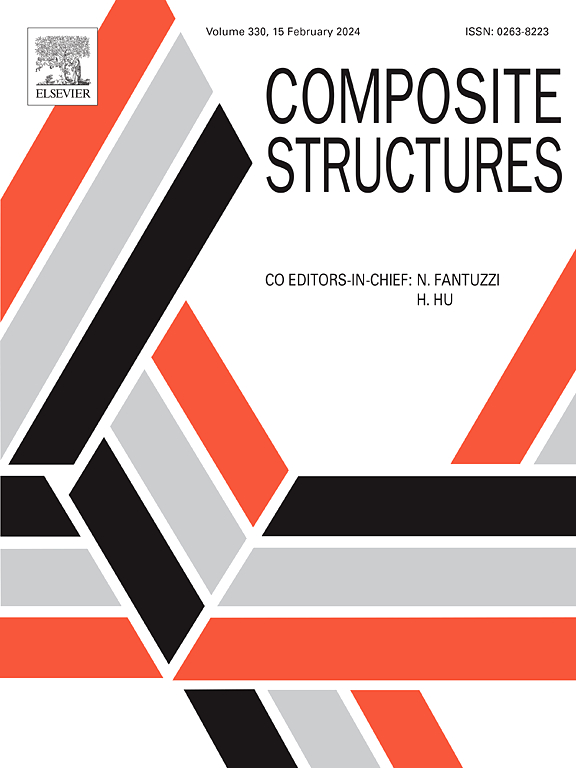IF 6.3
2区 材料科学
Q1 MATERIALS SCIENCE, COMPOSITES
引用次数: 0
摘要
玻璃纤维聚合物复合材料在荷载作用下通常表现出线性应力-应变行为,直到突然失效,而不会出现挠曲作为失效前的警告。本研究在玻璃纤维聚合物面层和木材芯材的夹层梁配置中引入了非线性弹塑性粘合层,从而实现了由负载相关的复合作用所产生的非线性和韧性弯曲行为。实验研究、有限元(FE)建模和经典梁理论被用来了解粘合剂特性、木材类型和跨度深度比对这种夹层梁弯曲行为的影响。对使用弹性丙烯酸粘合剂或弹性环氧树脂粘合剂以及软木或硬木芯材的试样进行了比较分析。结果发现,丙烯酸粘合剂和软木芯材可有效提供延展性和失效前挠度。对于使用硬木芯材的试样,环氧树脂粘合剂在大部分加载过程中提供了复合作用和线性载荷-挠度行为;而丙烯酸粘合剂由于在剪切作用下的应力-应变行为与载荷有关,因此提供了部分复合作用和双线性载荷-挠度行为,显示出更大的跨中挠度和延展性。有限元模型很好地描述了试样的挠曲行为,包括挠度随荷载的变化、弯曲刚度和复合作用。本文章由计算机程序翻译,如有差异,请以英文原文为准。
Ductile flexural behavior of composite sandwich structures with brittle fibre polymer facesheets and timber core
Glass fibre polymer composites under loading usually exhibit a linear stress–strain behavior until a sudden failure without yielding as a pre-failure warning. This study introduced a non-linear elastoplastic adhesive layer in a sandwich beam configuration with glass fibre polymer facesheets and timber cores, where nonlinear and ductile flexural behavior resulted from load-dependent composite action was achieved. Experimental investigation, finite element (FE) modelling and classic beam theory were used to understand the effects of adhesive properties, timber types and span-to-depth ratios on the flexural behavior of such sandwich beams. Comparative analyses were conducted among specimens with elastoplastic acrylic or elastic epoxy adhesives, as well as softwood or hardwood timber cores. It can be found that the acrylic adhesive and softwood cores effectively offered ductility and pre-failure deflection. For the specimens with hardwood cores, the epoxy adhesive provided a composite action and linear load–deflection behavior in most of the loading process; while due to a load-dependent stress–strain behavior under shearing, the acrylic adhesive provided a partial composite action and bilinear load–deflection behavior, showing increased mid-span deflection and ductility. Finite element modelling well described the flexural behaviors of the specimens, including deflection development with loads, bending stiffness and composite action.
求助全文
通过发布文献求助,成功后即可免费获取论文全文。
去求助
来源期刊

Composite Structures
工程技术-材料科学:复合
CiteScore
12.00
自引率
12.70%
发文量
1246
审稿时长
78 days
期刊介绍:
The past few decades have seen outstanding advances in the use of composite materials in structural applications. There can be little doubt that, within engineering circles, composites have revolutionised traditional design concepts and made possible an unparalleled range of new and exciting possibilities as viable materials for construction. Composite Structures, an International Journal, disseminates knowledge between users, manufacturers, designers and researchers involved in structures or structural components manufactured using composite materials.
The journal publishes papers which contribute to knowledge in the use of composite materials in engineering structures. Papers deal with design, research and development studies, experimental investigations, theoretical analysis and fabrication techniques relevant to the application of composites in load-bearing components for assemblies, ranging from individual components such as plates and shells to complete composite structures.
 求助内容:
求助内容: 应助结果提醒方式:
应助结果提醒方式:


